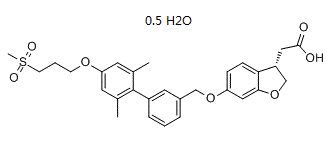All AbMole products are for research use only, cannot be used for human consumption.

Fasiglifam (TAK-875) Hemihydrate is a novel, orally available, selective GPR40 agonist. TAK-875 exhibits potent agonist activity and high binding affinity to the human GPR40 receptor with Ki of 38 nM. TAK-875 enhanced glucose-induced insulin secretion in a glucose-dependent manner in both human and rat islets. In rat insulinoma INS-1 833/15 cells, TAK-875 increased intracellular inositol monophosphate and calcium concentration, consistent with activation of the Gqα signaling pathway. In addition, TAK-875 (10 mg/kg, p.o.) significantly augmented plasma insulin levels and reduced fasting hyperglycemia in male Zucker diabetic fatty rats, whereas in fasted normal Sprague-Dawley rats, TAK-875 neither enhanced insulin secretion nor caused hypoglycemia even at 30 mg/kg. TAK-875 improves both postprandial and fasting hyperglycemia with a low risk of hypoglycemia and no evidence of β cell toxicity. TAK-875 significantly improved glycaemic control in patients with type 2 diabetes with minimum risk of hypoglycaemia.
| Cell Experiment | |
|---|---|
| Cell lines | INS-1 832/13 cells |
| Preparation method | Measurement of Caspase 3/7 Activity. INS-1 832/13 cells were suspended in RPMI medium containing 11 mM glucose and the supplements described above. These cells were seeded at a density of 2 × 104 cells/well in a 96-well black plate coated with poly-D-lysine (BD BioCoat), and 1% BSA and 0.1% DMSO alone (control), palmitic acid (62.5, 125, 250, 500, and 1000 μM), oleic acid (62.5, 125, 250, 500, and 1000 μM), or TAK-875 (6.25, 12.5, 25, 50, and 100 μM) was added to the plate with 1% BSA and 0.1% DMSO, followed by culture for 72 h. After the culture, caspase 3/7 activity was measured with the Apo-one homogeneous caspase 3/7 assay (Promega, Madison, WI) according to the manufacturer's instructions. Fluorescence intensity was measured at an excitation of 485 nm and an emission at 535 nm. |
| Concentrations | 6.25, 12.5, 25, 50, and 100 μM |
| Incubation time | 72 h |
| Animal Experiment | |
|---|---|
| Animal models | Oral Glucose Tolerance Test and Effects on Fasting Normoglycemia and Hyperglycemia with N-STZ-1.5 rats |
| Formulation | 0.5% methylcellulose |
| Dosages | 10 and 30 mg/kg |
| Administration | oral gavage |
| Molecular Weight | 533.63 |
| Formula | C29H32O7S.1/2H2O |
| CAS Number | 1374598-80-7 |
| Solubility (25°C) | DMSO 90 mg/mL |
| Storage |
Powder -20°C 3 years ; 4°C 2 years In solvent -80°C 6 months ; -20°C 1 month |
| Related GPR/FFAR Products |
|---|
| GPR84 antagonist 8
GPR84 antagonist 8 is a selective GPR84 antagonist. |
| ML191
ML-191 is an antagonist of GPR55. |
| CID1172084
CID1172084 is a selective GPR55 agonist (EC50=0.16 μM). |
| ML 145
ML 145 is a selective and competitive human GPR35/CXCR8 antagonist with an IC50/EC50 of 20.1 nM. |
| PSN 375963 hydrochloride
PSN 375963 hydrochloride is a potent GPR119 agonist, with EC50s of 8.4 and 7.9 μM for human and mouse GPR119, respectively. |
All AbMole products are for research use only, cannot be used for human consumption or veterinary use. We do not provide products or services to individuals. Please comply with the intended use and do not use AbMole products for any other purpose.


Products are for research use only. Not for human use. We do not sell to patients.
© Copyright 2010-2024 AbMole BioScience. All Rights Reserved.
